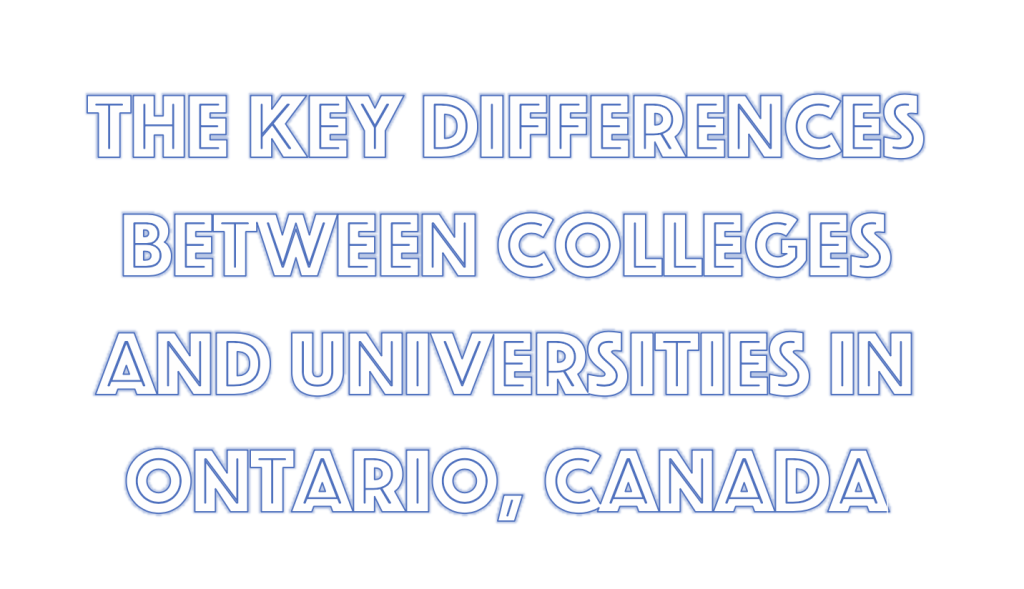The Key Differences Between Colleges and Universities in Ontario — In the Canadian province of Ontario, there are two primary options for higher education: colleges and universities. While both institutions offer valuable educational opportunities, they have distinct differences in terms of programs, credentials, learning environments, and career prospects. Understanding these differences is crucial for prospective students as they navigate their educational paths and make informed decisions about their future.
In this comprehensive guide, we will explore and discuss ten key differences between colleges and universities in Ontario. By examining these distinctions, students can gain a deeper understanding of each institution type and make well-informed choices that align with their goals and aspirations.
Table of Contents
Academic Programs and Credentials: Applied Skills vs. Theoretical Knowledge
One of the fundamental differences between colleges and universities in Ontario lies in the nature of their academic programs. Colleges predominantly offer applied programs that focus on practical skills development and hands-on training. These programs are designed to prepare students for specific careers or industries, such as business, healthcare, technology, or trades. In contrast, universities provide a broader range of programs that emphasize theoretical knowledge and research.
Universities offer undergraduate and graduate degrees in various disciplines, allowing students to delve deep into a specific field of study and pursue advanced research opportunities.
Read Also: How Many Colleges are in Ontario? Exploring Higher Education
Degree Offerings: Diplomas and Certificates vs. Bachelor’s, Master’s, and Doctoral Degrees
Colleges in Ontario primarily offer diplomas and certificates upon completion of their programs. These credentials signify a level of proficiency in a specific field and are recognized by employers in relevant industries.
On the other hand, universities confer bachelor’s, master’s, and doctoral degrees. These degrees are more comprehensive and academic in nature, providing students with a broad education and specialized knowledge in their chosen discipline. University degrees are widely recognized and may be required for certain professions or advanced academic pursuits.
Learning Environment and Class Sizes: Small Cohorts vs. Large Lecture Halls
The learning environment and class sizes at colleges and universities in Ontario differ significantly. Colleges often cultivate a more intimate and hands-on learning experience, with smaller class sizes and a focus on student engagement. Students may benefit from more personalized attention from instructors, collaboration with peers, and practical learning opportunities.
Universities, due to their larger student populations, may have larger lecture-style classes, especially in the early years of undergraduate studies. However, as students progress through their programs and select specialized courses, class sizes tend to become smaller, allowing for more interaction with professors and fellow students.
Research Opportunities and Academic Focus: Applied Research vs. Theoretical Inquiry
While universities are known for their emphasis on research, colleges in Ontario also offer research opportunities, albeit with a different focus. Universities often prioritize theoretical research, encouraging students to contribute to existing knowledge and push the boundaries of their respective fields. This research is typically conducted in collaboration with faculty members and may lead to publications or presentations at academic conferences.
Colleges, on the other hand, emphasize applied research that addresses industry-specific challenges and contributes to practical solutions. Students may engage in research projects with a direct impact on their chosen fields or professions.
Co-op Programs and Industry Connections: Practical Experience and Employability
Both colleges and universities in Ontario recognize the importance of practical experience and strong industry connections for student employability. Colleges often integrate co-operative education (co-op) programs into their curriculum, providing students with structured work terms that allow them to apply their classroom learning in real-world settings. These programs enhance students’ skills, build professional networks, and increase their job prospects upon graduation.
Universities, while offering co-op programs as well, typically have a stronger emphasis on academic research and theoretical study, which can also contribute to career advancement, particularly in research-oriented or specialized fields.
Cost and Tuition: Affordability and Financial Considerations
Cost and tuition are significant factors to consider when deciding between colleges and universities in Ontario. Generally, colleges have lower tuition fees compared to universities, making them a more affordable option for many students. This can be particularly advantageous for individuals who want to minimize student debt or have limited financial resources.
Moreover, colleges often offer shorter program durations, allowing students to enter the workforce more quickly and start earning sooner. However, it’s essential to weigh the long-term career prospects and earning potential associated with university degrees, as they may justify the higher upfront investment for some students.
Admission Requirements and Selectivity: Academic Prerequisites and Competitiveness
The admission requirements and selectivity criteria vary between colleges and universities in Ontario. Colleges typically have more accessible admission requirements, focusing primarily on high school grades or equivalent academic credentials. While some programs may have specific prerequisites or additional requirements, the overall admission process is generally more straightforward.
Universities, especially those with competitive programs, may have more rigorous admission criteria, including higher grade point averages, standardized test scores (such as the SAT or ACT), and additional application components such as personal statements or reference letters. The selectivity of university programs varies depending on the program’s popularity and demand.
Campus Facilities and Resources: Specialized Facilities vs. Comprehensive Infrastructure
Both colleges and universities in Ontario strive to provide students with access to various campus facilities and resources. Colleges often boast specialized facilities that align with their program offerings, such as laboratories, simulation centers, trade workshops, and industry-specific equipment. These resources are designed to enhance students’ practical skills and provide a hands-on learning experience.
Universities, given their larger campuses and diverse academic programs, typically offer comprehensive infrastructure, including libraries, research centers, athletic facilities, arts spaces, and student support services. These resources cater to a broad range of academic and extracurricular interests.
Student Life and Campus Culture: Community and Extracurricular Engagement
Student life and campus culture differ between colleges and universities in Ontario. Colleges often foster a tight-knit community and a supportive environment, where students can actively engage in extracurricular activities, clubs, and events. Due to smaller student populations, it may be easier for students to develop strong connections with their peers, faculty, and staff.
Universities, with their larger and more diverse student bodies, offer a wide range of extracurricular opportunities, clubs, and organizations. Students can explore diverse interests, engage in cultural or academic societies, and participate in student government or leadership roles.
Career Outcomes and Pathways: Practical Skills vs. Theoretical Knowledge
The career outcomes and pathways associated with colleges and universities in Ontario reflect the differences in their educational approaches. College programs emphasize practical skills and hands-on training, preparing students for specific careers and industries. Graduates often enter the workforce directly, armed with the applied skills and knowledge required for their chosen fields.
Universities, with their focus on theoretical knowledge and research, equip students with critical thinking abilities, analytical skills, and a broader understanding of their discipline. This foundation can lead to career opportunities in a wide range of fields, including research, academia, professional services, and leadership roles.
Conclusion
Understanding the key differences between colleges and universities in Ontario is vital for prospective students as they make decisions about their higher education journey. The distinctions in academic programs, credentials, learning environments, research opportunities, co-op programs, costs, admission requirements, campus facilities, student life, and career outcomes highlighted in this guide provide valuable insights for students seeking the best educational fit.
By considering their career goals, learning preferences, and personal circumstances, individuals can make informed choices that align with their aspirations, ensuring a fulfilling educational experience and a strong foundation for their future endeavors.
Ultimately, the decision between a college and a university in Ontario should align with an individual’s aspirations, interests, and desired career outcomes. By thoroughly researching and understanding the distinctions between colleges and universities, students can embark on an educational path that best suits their needs, ensuring a rewarding and fulfilling experience as they pursue their academic and professional goals.




Pingback: What are the Resources for Exploring Colleges in Ontario - Schools in Ontario